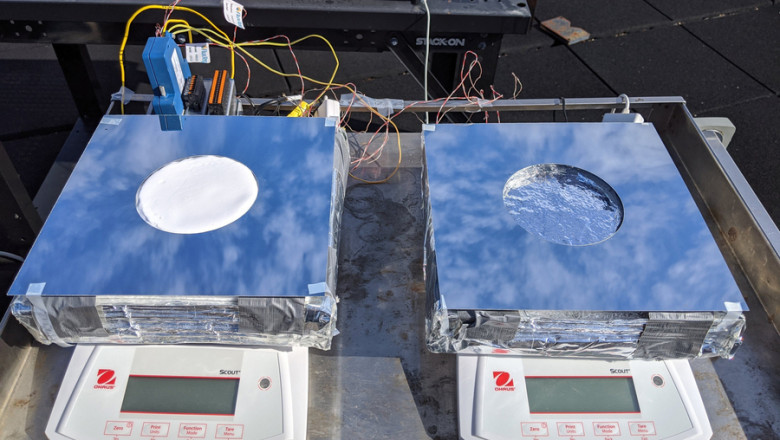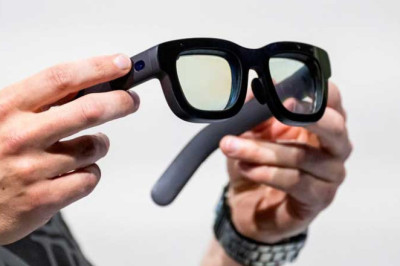
views
Passive cooling system could benefit off-grid locations
Introduction
As the world experiences rising temperatures, the increased reliance on power-intensive air conditioning systems poses significant challenges to power grids and limits cooling options in areas with unreliable electricity access. However, researchers at MIT have developed a groundbreaking system that utilizes passive cooling to extend the shelf life of food crops and complement traditional air conditioning units. This system requires no electricity and minimal water usage, offering a sustainable and cost-effective solution.
Combining Radiative Cooling, Evaporative Cooling, and Thermal Insulation
The newly developed system integrates radiative cooling, evaporative cooling, and thermal insulation into a slim package that resembles conventional solar panels. The system has the capacity to provide up to 19 degrees Fahrenheit (9.3 degrees Celsius) of cooling from the ambient temperature, enabling safe food storage for 40% longer periods in highly humid conditions. In drier environments, the system can triple the safe storage time.
The researchers published their findings in the journal Cell Reports Physical Science. The study was conducted by MIT postdoc Zhengmao Lu, Arny Leroy PhD '21, and professors Jeffrey Grossman and Evelyn Wang, among others. The Abdul Latif Jameel Water and Food Systems Lab at MIT provided partial support for the research.
Advancing Cooling Technology
By cleverly combining separate cooling designs, each with limited cooling capacity, the research team achieved a substantial overall cooling effect. This breakthrough can significantly reduce food losses due to spoilage, especially in regions grappling with limited food supplies. Additionally, the system could alleviate the strain on existing air conditioning units in buildings by channeling cool water to the condenser, the system's hottest component. Lowering the condenser temperature improves the efficiency of air conditioners, resulting in energy savings.
Superior Performance in High-Humidity Areas
Passive cooling technologies have been previously explored, but their effectiveness in high-humidity regions has been limited. The MIT system overcomes this challenge by synergistically combining evaporative and radiative cooling. This breakthrough enables the achievement of high cooling performance, even in areas with high humidity.
System Design and Functionality
The system comprises three material layers that facilitate cooling as water and heat pass through. Resembling a conventional solar panel, the device can provide direct cooling or supply chilled water through pipes to enhance the efficiency of existing air conditioning systems. Maintenance is minimal, with water replenishment for evaporation required approximately every four days in the hottest, driest areas and once a month in wetter regions.
The top layer is an aerogel, a material consisting mostly of air enclosed in a polyethylene-based sponge-like structure. It allows water vapor and infrared radiation to pass through while providing excellent insulation. Evaporation from the layer below contributes to the cooling effect, while infrared radiation releases heat into space, unlike air conditioners that release hot air into the immediate environment.
Beneath the aerogel, a hydrogel layer, filled with water rather than air, acts as a water source for evaporative cooling. The water vapor passes through the aerogel layer and dissipates into the environment. A reflective layer beneath the hydrogel prevents solar absorption, reflecting incoming sunlight back through the system and reducing thermal load. The top aerogel layer also reflects solar radiation and limits solar heating of the device.
Challenges and Future Developments
While the system's overall efficiency relies on the properties of the aerogel material, its current production cost is high. Special equipment for critical point drying (CPD) is required to remove solvents slowly from the delicate porous structure without causing damage. The research team is exploring cost-effective alternatives, such as freeze-drying, and investigating other materials that can offer similar insulation at a lower cost.
Conclusion
MIT's innovative passive cooling system demonstrates the potential to address cooling needs in regions where electricity and water scarcity limit conventional cooling technologies. By combining evaporative and radiative cooling with thermal insulation, the system offers enhanced cooling performance. Although further development is needed to reduce the cost of the aerogel component, the system shows promise for widespread practical applications, including food preservation.




















Comments
0 comment